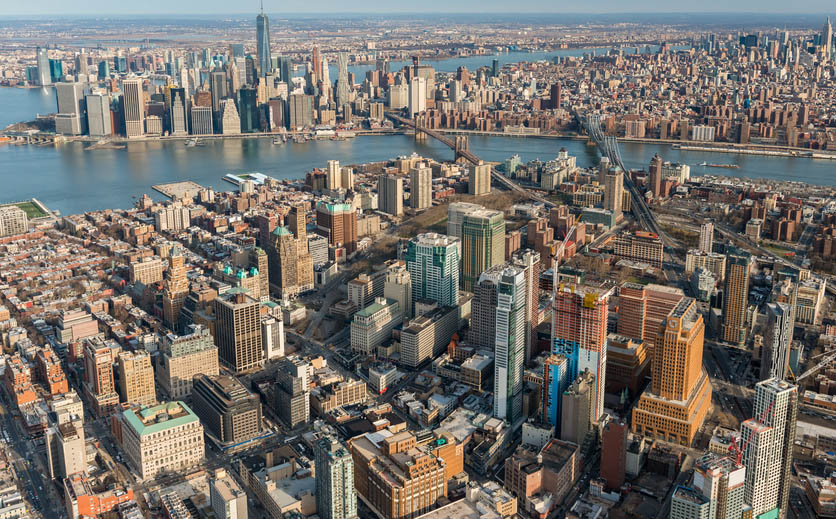This week, Bre Pettis, the co-founder of MakerBot and one of Brooklyn’s most creative entrepreneurs, will step down as co-chair of the Downtown Brooklyn Partnership (DBP). This is a natural progression of leadership for a civic organization that periodically hands the torch from one steward to another. However, what Bre’s leadership helped the Downtown Brooklyn Partnership to accomplish during his nearly four-year tenure is truly remarkable.
Bre was a reluctant convert. In 2012, confronting a steadily increasing office vacancy rate in Downtown Brooklyn, the board of directors of DBP handed me one overarching mandate as president of the group: turn the vacancy rate around. As we considered new asset-management strategies and ways to recast the attractive qualities of our local office market, my colleague at the time, Tom Conoscenti (now an administrator in the Cuomo Administration), had another idea. We should just roll up our sleeves, he said, and go visit some of the area’s largest employers to see if we could convince them to come to Downtown Brooklyn.
His One Simple Request
Bre, who was running MakerBot from Boerum Hill at the time, took our meeting. But his wariness of government assistance in the private sector and his reluctance about Downtown Brooklyn was evident from the start. After a few months of wooing, we won him over and he moved Makerbot’s Headquarters to MetroTech, helping to pave the way for other creative companies like Tough Mudder and Slate magazine to join the campus. Even more traditional players like NYU and JP Morgan soon began to sit up and pay attention again to changes in the area. NYU announced a $500 million expansion of its Downtown Brooklyn presence and JP Morgan soon after doubled down on its Brooklyn assets.

An aerial view of downtown Brooklyn’s rising skyline of residential and office buildings (Photo credit: Richard Cavalleri/ Shutterstock.com)
At the time Bre made me promise only one thing: that we would work to open more bars in the area, a seemingly trivial request. But even then, he understood that for Downtown Brooklyn to succeed we needed more amenities and gathering spaces to attract innovation companies to the area. And I knew we needed him involved with the partnership. He became co-chair soon thereafter.
During Bre’s tenure, the local office market absorbed more than 1 million square feet of vacant space, bringing thousands of jobs and important investment to Brooklyn, and lowering the area’s office vacancy rate to historic lows. Even after Bre sold MakerBot, he stayed close to home and began new ventures in the Brooklyn Navy Yard, in the heart of the Brooklyn Tech Triangle that he helped create.
Bringing Up the Next Gen
He also doubled down on his engagement with turning Downtown Brooklyn into a center for innovation, creativity and entrepreneurship. He pushed us to create real partnerships between local colleges and universities and the private sector which led to the creation of the Brooklyn Education Innovation Network. And he was not shy about pointing out to students that while college may be the way many students get access to technical tools, he urged them to make things that will impress firms. Good grades alone are not enough in today’s highly competitive and fast moving economy. It’s ideas and execution that matter.
He conceived of the Make It in Brooklyn Summit to highlight the world-class talent and ideas emanating from Brooklyn. And in the conference’s first year, it produced the definitive founder’s story discussion between Bruce Ratner and David Walentas, that for posterity alone belongs in the Brooklyn archives.
He thought it was important to seed the next generation of entrepreneurs in Brooklyn. And to do it, he volunteered his own money (as did his Co-chair MaryAnne Gilmartin of Forest City Ratner Companies) to help kick off a successful series of pitch contests to help fledgling businesses in Brooklyn, often supporting minority and women entrepreneurs–the authentic face of Brooklyn–in the process.
On a personal level, he was always encouraging, but discerning and direct, and erring on the side of courage. His work with Downtown Brooklyn was never about ego, but about what would create opportunities for Brooklynites.
But don’t worry, Downtown Brooklyn will go on without Bre in charge. His co-chair Gilmartin remains at the helm of the board. With the talented Regina Myer now in place as DBP president, the organization remains in capable hands. But if you see Bre on the streets of Brooklyn, give him a high five or a hug, and thank him for his service to Brooklyn. He deserves it.